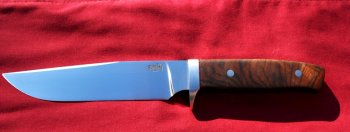ricky_arthur
Well-Known Member
I can't figure out why I'm so enamored with Bowie knives right now. In all honesty they serve no practical purpose when it comes to what I actually use a knife for. There are certainly more practical hunting knives and I would probably never use one for that.. I carry a Small EDC folder for everyday tasks. They are much more difficult and time consuming to make just based on sheer size. Yet here I am making not 1 but 2 Bowies at the same time. And loving every minute of it. It's 1 am and here I am trying to decide what I should use for the handle. The first ones handle is finished just have to clean and polish the guard.

But what to do for this one?

here are my Options.

I don't even know how to attach a guard for this type of knife, which is why the first one became a hidden tang. I ordered some silver solder as I suppose that is the only way to do it, but how do I use 450 degree silver solder and not take the temper from the blade. Clamp the knife in a vice with a wet rag?
What is it about a Bowie knife?

But what to do for this one?

here are my Options.

I don't even know how to attach a guard for this type of knife, which is why the first one became a hidden tang. I ordered some silver solder as I suppose that is the only way to do it, but how do I use 450 degree silver solder and not take the temper from the blade. Clamp the knife in a vice with a wet rag?
What is it about a Bowie knife?


